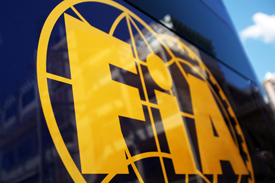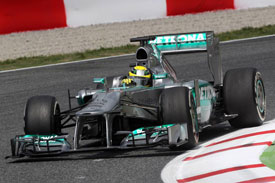| By Jonathan Noble | Wednesday, June 19th 2013, 11:41 GMT |
 Formula 1's attention moves to the FIA's headquarters in Paris on Thursday for an International Tribunal (IT) hearing into the Mercedes secret test controversy.
Formula 1's attention moves to the FIA's headquarters in Paris on Thursday for an International Tribunal (IT) hearing into the Mercedes secret test controversy.
The case marks new territory for everyone involved, because it is the first time that the IT has been called in to use for such a high-profile matter.
F1's previous controversies, like the McLaren spy case in 2007 and the Singapore race fix scandal, were ruled on by the FIA's own World Motor Sport Council.
AUTOSPORT explains exactly what the IT is, how it works and what it could do.
![]() Rules not details key to Paris hearing
Rules not details key to Paris hearing
WHO SITS ON THE INTERNATIONAL TRIBUNAL?
The International Tribunal (IT) was set up in 2010 by the FIA General Assembly as part of a new judicial system.
Its remit is to rule on matters that cannot be immediately dealt with by race stewards.
The FIA statutes state: "The IT hears cases that have been submitted to it.
"It applies and interprets the present Rules with the aim of enforcing the Statutes and Regulations of the FIA, including the International Sporting Code."
The current president of the IT is Briton Edwin Glasgow, with the vice-president Laurent Anselmi coming from Monaco.
One of the key elements of the IT - a 12-man panel - is that it is completely separate from the governing body.
In the FIA statutes, it is declared: "The IT operates totally independently from the other bodies of the FIA and the members of the FIA."
HOW WILL THE TRIBUNAL HEARING WORK?
Once it was decided that Mercedes and Pirelli had a case to answer, then the President of the IT has to appoint a panel made up of at least three members - one of whom will be designated 'the President of the Hearing'.
The exact composition of the panel has not yet been confirmed - although some of the 12 IT members are automatically ruled out.
To ensure independence, no members of the judging panel will be allowed to be the same nationality as one of the main parties of the case.
With Mercedes racing under a German licence, and Pirelli being an Italian company, then judges from both those countries cannot be allowed to take part.
Both defence and other interested parties have already asked to submit written evidence before the hearing - and the final proceedings will be open to the media.
WHAT WILL THE TRIBUNAL BE LOOKING AT?
One of Mercedes' explanations for running a 2013 car at the Barcelona test was that it received notification from the FIA that it would be OK to do so.
 The FIA in its only public statement so far suggested that such approval was conditional on the Pirelli test opportunity being available to other teams.
The FIA in its only public statement so far suggested that such approval was conditional on the Pirelli test opportunity being available to other teams.
Pirelli itself has stated several times that it did offer every team the chance to take part in its planned testing programme.
While the details of the correspondence between the FIA, Mercedes and Pirelli will be of interest to onlookers, such intricate elements of the case may not matter so much to the IT.
Its role instead is to simply decide whether or not there has been a breach of the regulations.
Mercedes' rivals are adamant that the team running its 2013 car in testing at Barcelona was breaking the rules, irrespective of any separate agreement that existed with Pirelli.
The IT statutes make it clear: "Unless stated otherwise, offences or infringements are punishable, whether they were committed intentionally or negligently."
WHAT PUNISHMENTS CAN IT HAND OUT?
The IT plans to announce its verdict on the matter as soon as possible after the hearing finishes - although that may not be until Friday if its deliberations take some time.
If the IT decides that there has been a breach of the rules, then the judging panel will hand out whatever punishment it thinks is appropriate.
Although there have been some suggestions that one sensible solution to ensure parity for the teams would be to allow Mercedes' rivals a similar three-day Pirelli test, such an option does not appear possible under the FIA statutes.
 The IT's punishments are limited to fines, bans or the alternative sanctions laid out in the International Sporting Code (ISC).
The IT's punishments are limited to fines, bans or the alternative sanctions laid out in the International Sporting Code (ISC).
The ISC says available sanctions are listed in the order of severity: reprimand, fines, obligation to accomplish some work of public interest, time penalty, exclusion, suspension or disqualification.
The FIA also states: "For the FIA Formula One World Championship and the FIA World Rally Championship, a penalty consisting of the withdrawal of points over the whole of the Championship may be imposed.
"The International Tribunal may also impose directly bans on taking part or exercising a role, directly or indirectly, in events, meetings or championships organised directly or indirectly on behalf of or by the FIA, or subject to the regulations and decisions of the FIA."
AUTOSPORT will bring you live coverage from the FIA International Tribunal hearing.
Anda sedang membaca artikel tentang
How the International Tribunal works
Dengan url
http://pusingkepalawa.blogspot.com/2013/06/how-international-tribunal-works.html
Anda boleh menyebar luaskannya atau mengcopy paste-nya
How the International Tribunal works
namun jangan lupa untuk meletakkan link
How the International Tribunal works
sebagai sumbernya
0 komentar:
Posting Komentar